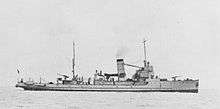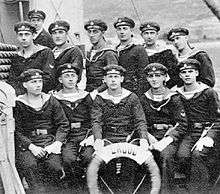Galeb-class minelayer
 Former German M 120 minesweeper in Italian service, similar to the Galeb class | |
| Class overview | |
|---|---|
| Operators: | |
| Built: | 1918–19 |
| In commission: | 1921–55 |
| Completed: | 6 |
| Lost: | 5 |
| Scrapped: | 1 |
| General characteristics | |
| Type: | Minelayer |
| Displacement: |
|
| Length: | |
| Beam: | 7.3 m (23 ft 11 in) |
| Draught: | 2.15 m (7 ft 1 in) |
| Installed power: | |
| Propulsion: |
|
| Speed: | 16 knots (30 km/h; 18 mph) |
| Endurance: | 2,000 nmi (3,700 km; 2,300 mi) at 14 knots (26 km/h; 16 mph) |
| Complement: | 51 |
| Armament: |
|
The Galeb class were minelayers originally built as minesweepers for the Imperial German Navy between 1918 and 1919. In July 1921, the six unarmed vessels were purchased as "tugs" for the navy of the newly-created Kingdom of the Serbs, Croats and Slovenes (from 1929, the Kingdom of Yugoslavia). Re-armed with two Škoda 90 mm (3.5 in) L/45 guns and two machine guns, they could carry 24 naval mines. They all served until April 1941, when they were captured by the Italians during the World War II German-led Axis invasion of Yugoslavia. They were then put into service by the Regia Marina under new names. Five of the ships were lost or sunk during World War II, the remaining vessel was put into service by the Yugoslav Navy after the war, and was finally deleted in 1962.
Description and construction
The Galeb class was built as 1916-designed M 1-class minesweepers by three German shipbuilding yards during 1917–19. Their German designations and builders were: M 97, M 100 and M 112 — Tecklenborg, Geestemünde; M 106 — Reiherstieg, Hamburg; M 121 and M144 — Neptun, Rostock. They used two three-cylinder vertical triple expansion engines driving two propeller shafts, using steam generated by two coal-fired boilers. They had a waterline length of 56.1 m (184 ft 1 in), an overall length of 59.58–59.63 m (195 ft 6 in–195 ft 8 in), a beam of 7.3 m (23 ft 11 in), and a normal draught of 2.15 m (7 ft 1 in). They had a designed displacement of 508 tonnes (500 long tons), and 548–560 tonnes (539–551 long tons) at deep load. The crew consisted of forty officers and men. Their engines were rated at 1,840–1,850 ihp (1,370–1,380 kW) and were designed to reach a top speed of 16 knots (30 km/h; 18 mph). They carried 115 tonnes (113 long tons) of coal, which gave them a radius of action of 2,000 nmi (3,700 km; 2,300 mi) at 14 knots (26 km/h; 16 mph). In German service they were armed with two 105 mm (4.1 in) SK L/45 naval guns,[lower-alpha 1] and carried 120 rounds for each gun. They could carry 30 naval mines, and with their minesweeping gear extended, they could maintain a maximum speed of 12.5–13 knots (23.2–24.1 km/h; 14.4–15.0 mph).[1]
Service history

The six minesweepers were bought as unarmed "tugs" by the government of the Kingdom of Serbs, Croats and Slovenes (later Yugoslavia) on 20 July 1921, for 1,400,000 marks each. Their German designations were M97, M100, M106, M112, M121 and M144. Taken into service in the navy of the new kingdom, they were initially classified as mining tenders,[2] and renamed Orao (Eagle), Galeb (Seagull), Gavran (Raven), Jastreb (Hawk), Kobac (Sparrow Hawk), and Sokol (Falcon), respectively. They were rearmed with two Škoda 90 mm (3.5 in) L/45 guns and two machine guns, and could carry twenty-four mines. The crew was increased to fifty-one. In 1923, Gavran was renamed Labud (Swan).[3][4] In 1931, some of the guns were re-lined to 83.5 mm (3.29 in) to use the same ammunition as the dual-purpose guns fitted to the Yugoslav light cruiser Dalmacija.[5] The following year, the British naval attaché reported that Yugoslav ships were engaging in little gunnery training, and few exercises or manoeuvres, due to reduced budgets.[6] In August 1935, the seaplane carrier Zmaj accompanied by Galeb, Labud and Kobac visited the Greek island of Corfu.[7] By 1936, the class had been re-classified as minelayers.[8] In 1938–39 Jastreb was fitted for oil-firing only.[4][9]
During the World War II German-led Axis invasion of Yugoslavia in April 1941, all six ships were captured in port by the Italians.[4] Kobac was captured on 10 April at Šibenik, and the remainder were captured on 17 April: Sokol was captured at Split, and the rest at the Bay of Kotor. They were soon put into commission in the Regia Marina as Vergada (ex-Orao), Selve (ex-Galeb), Zuri (ex-Labud), Zirona (ex-Jastreb),[lower-alpha 2] Eso (ex-Sokol), and Unie (ex-Kobac).[4][10][11]
Zirona was damaged and beached near Benghazi on 24–25 November 1941 after a British air raid, and was destroyed by the Italians on 28 November.[4][12] Selve was damaged by a Royal Air Force air raid at Benghazi on 6 November 1942, and burned out,[13] finally being broken up in 1948.[11] Eso was torpedoed by Royal Navy aircraft 7 km (4.3 mi) east of Djerba Island off the Tunisian coast on 19 January 1943,[4][14] while on escort duty with the Palestro-class torpedo boat San Martino and two other vessels.[15] Unie was destroyed by an explosion at Bizerta following an air raid by United States Army Air Forces aircraft on 30 January 1943.[16] The last of the class to be sunk during the war was Zuri, which had been renamed Oriole in June 1942.[9] She was scuttled by her crew on 10 July 1943 at Augusta, Sicily, in the face of advancing British troops,[4] following damage sustained in an air attack south of Messina.[17] The surviving vessel, Vergada, was recovered and handed back to the Royal Yugoslav Navy at Malta on 7 December 1943.[10] She remained in service through the rest of the war, and became part of the post-war Yugoslav Navy, serving as Pionir from August 1945, and as Zelengora from 1955. She was finally disposed of in 1962.[4][11]
See also
Notes
Footnotes
- ↑ Gröner 1991, pp. 112–114.
- ↑ Vego 1982, p. 347.
- ↑ Vego 1982, p. 356.
- 1 2 3 4 5 6 7 8 Chesneau 1980, p. 357.
- ↑ Friedman 2011, p. 292.
- ↑ Jarman 1997, p. 451.
- ↑ Jarman 1997, p. 641.
- ↑ Vego 1982, p. 350.
- 1 2 3 Gröner 1991, p. 118.
- 1 2 Brown 1995, p. 44.
- 1 2 3 Gröner 1991, p. 117.
- ↑ Brown 1995, p. 52.
- ↑ Brown 1995, p. 71.
- ↑ Brown 1995, p. 80.
- ↑ Gröner 1991, p. 119.
- ↑ Brown 1995, p. 81.
- ↑ Brown 1995, p. 88.
References
Books
- Brown, David (1995). Warship Losses of World War Two. Annapolis, Maryland: Naval Institute Press. ISBN 978-1-55750-914-7.
- Chesneau, Roger, ed. (1980). Conway's All the World's Fighting Ships, 1922–1946. London, England: Conway Maritime Press. ISBN 978-0-85177-146-5.
- Friedman, Norman (2011). Naval Weapons of World War I. Annapolis, Maryland: Naval Institute Press. ISBN 978-1-84832-100-7.
- Gröner, Erich (1991). Jung, Dieter; Maass, Martin, eds. U-boats and Mine Warfare Vessels. German Warships 1815–1945. 2. Translated by Thomas, Keith; Magowan, Rachel. London, England: Conway Maritime Press. ISBN 0-85177-593-4.
- Jarman, Robert L., ed. (1997). Yugoslavia Political Diaries 1918–1965. 2. Slough, Berkshire: Archives Edition. ISBN 978-1-85207-950-5.
Journals
- Vego, Milan (1982). "The Yugoslav Navy 1918–1941". Warship International. Toledo, Ohio: International Naval Research Organisation (4): 342–361. ISSN 0043-0374.